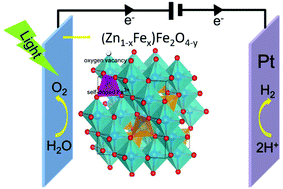Defective Fe3+ self-doped spinel ZnFe2O4 with oxygen vacancies for highly efficient photoelectrochemical water splitting†
Abstract
Defective Fe3+ self-doped spinel ZnFe2O4 with abundant oxygen vacancies, (Zn1−xFex)Fe2O4−y, was successfully synthesized via a simple spin-coating method and subsequent hydrogen reduction treatment. It displays a photocurrent density of 0.22 mA cm−2 at 1.23 (V vs. RHE), which is 11 times higher than that of pure ZnFe2O4. The largely enhanced photoelectrochemical (PEC) performance can be mainly ascribed to the synergism of the numerous oxygen vacancies and self-doped Fe3+, which has never been discussed carefully. Self-doped Fe3+ can be beneficial for increasing the charge carrier densities, while oxygen vacancies can improve the charge mobility and prompt the charge transfer process at the electrolyte interface, leading to improved electric conductivities and faster water oxidation kinetics. Furthermore, the effects of the concentrations of Fe3+ self-doping as well as oxygen vacancies on the PEC activities of ZnFe2O4 were also investigated. This work develops a novel and effective strategy to solve the critical problems existing in ZnFe2O4 for PEC applications and sheds light on the rational design of photoanode materials for efficient PEC water splitting.



 Please wait while we load your content...
Please wait while we load your content...